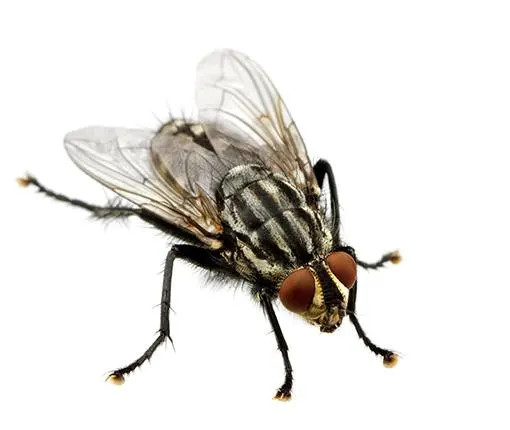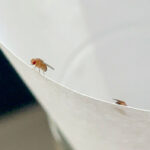Flies, those buzzing, bothersome insects, have plagued households for centuries. More than just a nuisance, they pose a health risk, capable of transmitting diseases. Common houseflies, often called “filth flies,” thrive in unsanitary environments, breeding in decaying food, animal waste, and garbage. Their rapid life cycle, from egg to adult in as little as ten days, means a small fly problem can quickly escalate into a full-blown infestation.
The good news? Getting rid of flies in your house is achievable with the right strategies. Effective fly control hinges on two key principles: sanitation and exclusion. By eliminating their breeding grounds and preventing their entry, you can significantly reduce and even eradicate fly populations in your home.
This comprehensive guide will walk you through identifying different types of flies and implementing effective methods to get rid of them and keep them away for good.
 How to Get Rid of Flies
How to Get Rid of Flies
Effective Fly Control Strategies
A successful fly control plan starts with diligent sanitation and exclusion practices. These preventative measures are crucial for long-term fly management. While insecticides can offer immediate relief, they are most effective when combined with addressing the root causes of fly infestations.
Integrated Fly Management Techniques
For a multi-pronged approach to fly control, consider integrating these methods:
- Sanitation: This is the cornerstone of fly control. Eliminating breeding sites is paramount.
- Exclusion: Prevent flies from entering your home in the first place.
- Trapping: Utilize various fly traps to capture and eliminate adult flies.
- Insecticides: Use insecticides strategically as a supplementary measure, not as the primary solution. Options include residual sprays, aerosols, foggers, and baits.
Specific product types you might consider include liquid insecticide concentrates, insecticide dusts, pyrethrin aerosols for quick knockdown, fly light traps (especially effective in commercial settings), fogging solutions for broad area treatment, and fly baits to attract and kill flies. For persistent drain flies, particularly in kitchens and bathrooms, enzyme-based drain cleaners are highly effective in breaking down organic matter they breed in.
 Get Rid of Flies
Get Rid of Flies
Natural and DIY Remedies to Repel and Eliminate Flies
For those seeking natural and less toxic approaches to fly control, several effective remedies can be implemented, especially for indoor fly problems or outdoor perimeter defense.
Here are five effective natural methods to get rid of flies:
1. Homemade Rotten Food Fly Trap
Don’t discard overripe or spoiled food just yet! Transform it into a potent fly trap. Place rotten fruit or vegetable scraps in a container and tightly cover it with plastic wrap. Puncture small holes in the plastic – just large enough for flies to enter. Position this trap in areas with high fly activity. The enticing aroma of decay will lure flies inside, but they’ll struggle to escape and eventually perish. Dispose of the trap and its contents once it’s full or the flies are eliminated, and repeat as needed.
2. Apple Cider Vinegar and Dish Soap Fly Trap
This simple yet effective trap is a popular DIY solution. In a jar or disposable container, mix apple cider vinegar, a touch of sugar, and a few drops of dish soap. The sweet vinegar attracts flies, while the dish soap breaks the surface tension of the liquid, causing them to drown when they land. Place the trap in fly-prone areas and replace the solution as needed.
3. Red Wine Fly Trap
Leftover red wine can be repurposed as a fly trap. Pour a small amount of red wine into a bottle or jar. Add a few drops of dish soap. The fermenting fruit scent of red wine is irresistible to flies. Like the vinegar trap, the dish soap will trap and drown the flies that come to investigate.
4. Essential Oils as Natural Fly Repellents
Certain essential oils possess strong scents that flies find highly repellent. Harness the power of nature with oils like clove, pine, lemongrass, eucalyptus, lavender, mint, rosemary, peppermint, tea tree, and citronella. Lemon eucalyptus oil, in particular, is known for its effectiveness.
To use essential oils, soak strips of cloth or cotton balls with your chosen oil and place them in areas where flies are prevalent. Alternatively, create a natural fly repellent spray by diluting essential oils with water in a spray bottle and applying it to patios, decks, and other outdoor spaces. Always test essential oil sprays in an inconspicuous area first to ensure they don’t damage surfaces.
5. Fans and Citronella Candles for Outdoor Fly Control
For outdoor fly issues, especially in smaller areas like patios or porches, simple fans can be remarkably effective. Flies prefer calm air for flying; the moving air from a fan disrupts their flight patterns, making it difficult for them to land and linger.
Citronella candles are another well-known natural fly deterrent for outdoor spaces. While primarily used for mosquito control, citronella’s scent also repels flies. Strategically place citronella candles around your outdoor gathering areas to create a fly-free zone.
Identifying Fly Types: Key to Targeted Control
Accurate fly identification is crucial for effective control. Different fly species may be attracted to different sources and require slightly different strategies. Broadly, flies can be categorized into three main groups:
Filth Flies
Filth flies, including common house flies, are not only a nuisance but also a significant health concern. Their feeding and breeding habits in garbage, manure, and decaying matter make them vectors for disease-causing organisms. They can easily contaminate food and food preparation surfaces, spreading illnesses like food poisoning and dysentery.
Common Types of Filth Flies: House Flies, Flesh Flies, Blow Flies.
Small Flies
Small flies, often less than 1/4 inch in size, are frequently found in kitchens and food handling areas. Like filth flies, they can carry and transmit disease-causing pathogens.
Common Types of Small Flies: Fruit Flies, Drain Flies, Phorid Flies, Fungus Gnats.
Nuisance and Biting Flies
While many flies are simply a nuisance, some species are also biting flies, feeding on blood. These flies often breed in decaying organic matter and animal waste and can transmit bacteria and viruses. Biting flies like stable flies and horse flies can inflict painful bites on humans and animals.
Common Types of Nuisance and Biting Flies: Stable Flies, Horse Flies, Deer Flies, Cluster Flies.
Understanding the type of fly you’re dealing with helps pinpoint potential breeding sources and select the most appropriate control methods. For example, fruit flies are drawn to overripe fruit, while drain flies thrive in clogged drains.
Preventing Flies from Entering Your Home: Proactive Measures
Prevention is always better than cure. Taking proactive steps to prevent flies from entering your home is the most sustainable approach to long-term fly control.
Sanitation: The Foundation of Fly Prevention
Maintaining impeccable sanitation is the cornerstone of fly prevention. The primary goal is to eliminate or minimize fly larvae breeding sites and remove attractants for adult flies. Key sanitation practices include:
- Proper Waste Management: Store garbage in tightly sealed bins and dispose of it regularly. Clean garbage cans frequently with soap and water, and occasionally with a bleach solution to eliminate odors and fly eggs. Keep outdoor compost bins covered and away from the house.
- Pet Waste Removal: Promptly clean up pet waste in your yard. Pet feces are a prime breeding ground for flies.
- Food Storage: Store food, especially fruits and vegetables, properly. Use airtight containers for pantry items and refrigerate perishable goods. Don’t leave ripe fruit sitting out on countertops.
- Clean Spills Immediately: Wipe up any food or drink spills immediately to prevent attracting flies.
- Drain Maintenance: Regularly clean drains, especially kitchen and bathroom drains, to prevent drain fly infestations. Use enzyme-based drain cleaners to break down organic buildup.
- Eliminate Standing Water: Flies need moisture to breed. Eliminate standing water sources both indoors and outdoors. Fix leaky pipes, empty pet water bowls regularly, and ensure proper drainage around your property. Avoid overwatering indoor plants and ensure pots are well-drained.
- Address Decaying Organic Matter: Remove any decaying plant matter, straw, or animal matter from around your property. Clean up soiled flower bedding.
Exclusion: Keeping Flies Out
Preventing fly entry is just as important as eliminating breeding sites. Focus on these exclusion techniques:
- Seal Entry Points: Seal cracks and crevices in your home’s foundation, walls, and around windows and doors.
- Repair or Replace Screens: Ensure window and door screens are in good repair and fit tightly. Replace damaged screens immediately.
- Door and Window Management: Keep doors and windows closed as much as possible, especially during peak fly activity times (typically during warmer parts of the day).
- Air Curtains: For doorways that must remain open in commercial or high-traffic areas, consider installing air curtains. These create a downward flow of air that deters flies from entering, especially if the air velocity is 1,600 feet per minute or higher.
By combining diligent sanitation practices with effective exclusion methods, you can create a fly-unfriendly environment and significantly reduce fly problems in your home.
Explore Fly Control Products
Ready to take decisive action against flies? A range of fly control products is available to supplement your sanitation and exclusion efforts. From traps and baits to repellents and insecticides, you can find solutions for both indoor and outdoor fly infestations. Whether you’re battling house flies, fruit flies, or other species, explore available fly control products to find the right tools for your needs and reclaim your fly-free home.
Shop Fly Control Products
FAQs About Fly Control
What Attracts Flies to My Home or Garden?
Flies are primarily attracted to decaying organic matter, which includes food waste, garbage, pet waste, overripe fruits, and compost. They are also drawn to moisture and standing water sources. Odors from these sources are powerful attractants.
Are There Natural Remedies to Get Rid of Flies?
Yes, several effective natural remedies exist. These include traps using apple cider vinegar or red wine, essential oil repellents (like eucalyptus, peppermint, and citronella), and fly-repelling plants such as basil, lavender, and mint around your home. Fans and citronella candles can also deter flies in outdoor areas.
How Can I Prevent Flies from Entering My House?
Prevent flies by sealing cracks and openings, installing and maintaining window and door screens, practicing good sanitation (especially waste management and food storage), and keeping doors closed as much as possible.
How Do I Get Rid of Flies in My Kitchen/Food Areas Safely?
For kitchens and food areas, prioritize safe, non-toxic methods. Use traps like vinegar traps or sticky fly traps. Maintain strict cleanliness, store food in airtight containers, promptly clean spills, and regularly empty garbage. UV light traps are also effective and safe for indoor use.
Can Flies Transmit Diseases?
Yes, flies, particularly filth flies, are known vectors of various diseases. They can transmit bacteria, viruses, and parasites that cause illnesses like food poisoning, dysentery, typhoid fever, and cholera. Maintaining hygiene and controlling fly populations is crucial for preventing disease transmission.
